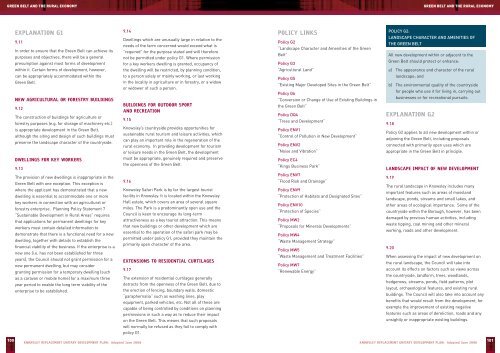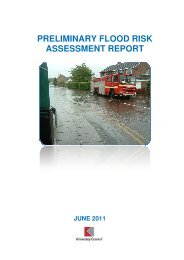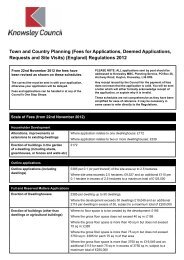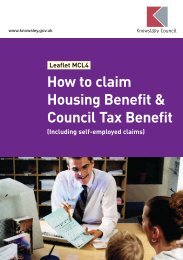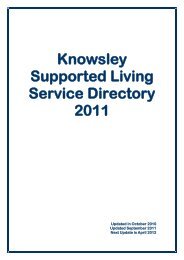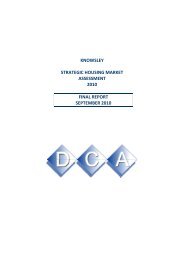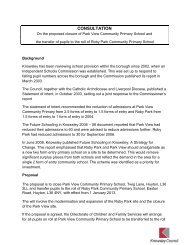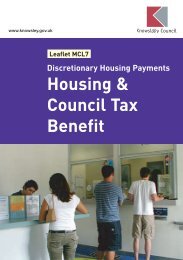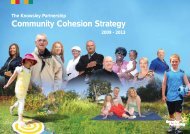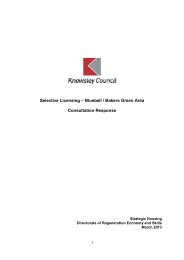Knowsley Replacement Unitary Development Plan - Knowsley Council
Knowsley Replacement Unitary Development Plan - Knowsley Council
Knowsley Replacement Unitary Development Plan - Knowsley Council
You also want an ePaper? Increase the reach of your titles
YUMPU automatically turns print PDFs into web optimized ePapers that Google loves.
GREEN BELT AND THE RURAL ECONOMY<br />
GREEN BELT AND THE RURAL ECONOMY<br />
EXPLANATION G1<br />
9.11<br />
In order to ensure that the Green Belt can achieve its<br />
purposes and objectives, there will be a general<br />
presumption against most forms of development<br />
within it. Certain forms of development, however,<br />
can be appropriately accommodated within the<br />
Green Belt.<br />
NEW AGRICULTURAL OR FORESTRY BUILDINGS<br />
9.12<br />
The construction of buildings for agriculture or<br />
forestry purposes (e.g. for storage of machinery etc.)<br />
is appropriate development in the Green Belt,<br />
although the siting and design of such buildings must<br />
preserve the landscape character of the countryside.<br />
DWELLINGS FOR KEY WORKERS<br />
9.13<br />
The provision of new dwellings is inappropriate in the<br />
Green Belt with one exception. This exception is<br />
where the applicant has demonstrated that a new<br />
dwelling is essential to accommodate one or more<br />
key workers in connection with an agricultural or<br />
forestry enterprise. <strong>Plan</strong>ning Policy Statement 7<br />
“Sustainable <strong>Development</strong> in Rural Areas” requires<br />
that applications for permanent dwellings for key<br />
workers must contain detailed information to<br />
demonstrate that there is a functional need for a new<br />
dwelling, together with details to establish the<br />
financial viability of the business. If the enterprise is a<br />
new one (i.e. has not been established for three<br />
years), the <strong>Council</strong> should not grant permission for a<br />
new permanent dwelling, but may consider<br />
granting permission for a temporary dwelling (such<br />
as a caravan or mobile home) for a maximum three<br />
year period to enable the long term viability of the<br />
enterprise to be established.<br />
9.14<br />
Dwellings which are unusually large in relation to the<br />
needs of the farm concerned would exceed what is<br />
“required” for the purpose stated and will therefore<br />
not be permitted under policy G1. Where permission<br />
for a key workers dwelling is granted, occupancy of<br />
the dwelling will be restricted, by planning condition,<br />
to a person solely or mainly working, or last working<br />
in the locality in agriculture or in forestry, or a widow<br />
or widower of such a person.<br />
BUILDINGS FOR OUTDOOR SPORT<br />
AND RECREATION<br />
9.15<br />
<strong>Knowsley</strong>’s countryside provides opportunities for<br />
sustainable rural tourism and leisure activities, which<br />
can play an important role in the regeneration of the<br />
rural economy. In providing development for tourism<br />
or leisure needs in the Green Belt, the development<br />
must be appropriate, genuinely required and preserve<br />
the openness of the Green Belt.<br />
9.16<br />
<strong>Knowsley</strong> Safari Park is by far the largest tourist<br />
facility in <strong>Knowsley</strong>. It is located within the <strong>Knowsley</strong><br />
Hall estate, which covers an area of several square<br />
miles. The Park is a predominantly open use and the<br />
<strong>Council</strong> is keen to encourage its long-term<br />
attractiveness as a key tourist attraction. This means<br />
that new buildings or other development which are<br />
essential to the operation of the safari park may be<br />
permitted under policy G1, provided they maintain the<br />
primarily open character of the area.<br />
EXTENSIONS TO RESIDENTIAL CURTILAGES<br />
9.17<br />
The extension of residential curtilages generally<br />
detracts from the openness of the Green Belt, due to<br />
the erection of fencing, boundary walls, domestic<br />
“paraphernalia” such as washing lines, play<br />
equipment, parked vehicles, etc. Not all of these are<br />
capable of being controlled by conditions on planning<br />
permissions in such a way as to reduce their impact<br />
on the Green Belt. This means that such proposals<br />
will normally be refused as they fail to comply with<br />
policy G1.<br />
POLICY LINKS<br />
Policy G2<br />
“Landscape Character and Amenities of the Green<br />
Belt”<br />
Policy G3<br />
“Agricultural Land”<br />
Policy G5<br />
“Existing Major Developed Sites in the Green Belt”<br />
Policy G6<br />
“Conversion or Change of Use of Existing Buildings in<br />
the Green Belt”<br />
Policy DQ4<br />
“Trees and <strong>Development</strong>”<br />
Policy ENV1<br />
“Control of Pollution in New <strong>Development</strong>”<br />
Policy ENV2<br />
“Noise and Vibration”<br />
Policy EC4<br />
“Kings Business Park”<br />
Policy ENV7<br />
“Flood Risk and Drainage”<br />
Policy ENV9<br />
“Protection of Habitats and Designated Sites”<br />
Policy ENV10<br />
“Protection of Species”<br />
Policy MW2<br />
“Proposals for Minerals <strong>Development</strong>s”<br />
Policy MW4<br />
“Waste Management Strategy”<br />
Policy MW5<br />
“Waste Management and Treatment Facilities”<br />
Policy MW7<br />
“Renewable Energy”<br />
POLICY G2:<br />
LANDSCAPE CHARACTER AND AMENITIES OF<br />
THE GREEN BELT<br />
All new development within or adjacent to the<br />
Green Belt should protect or enhance:<br />
a) The appearance and character of the rural<br />
landscape; and<br />
b) The environmental quality of the countryside<br />
for people who use it for living in, carrying out<br />
businesses or for recreational pursuits.<br />
EXPLANATION G2<br />
9.18<br />
Policy G2 applies to all new development within or<br />
adjoining the Green Belt, including proposals<br />
connected with primarily open uses which are<br />
appropriate in the Green Belt in principle.<br />
LANDSCAPE IMPACT OF NEW DEVELOPMENT<br />
9.19<br />
The rural landscape in <strong>Knowsley</strong> includes many<br />
important features such as areas of mossland<br />
landscape, ponds, streams and small lakes, and<br />
other areas of ecological importance. Some of the<br />
countryside within the Borough, however, has been<br />
damaged by previous human activities, including<br />
waste tipping, coal mining and other mineral<br />
working, roads and other development.<br />
9.20<br />
When assessing the impact of new development on<br />
the rural landscape, the <strong>Council</strong> will take into<br />
account its effects on factors such as views across<br />
the countryside, landform, trees, woodlands,<br />
hedgerows, streams, ponds, field patterns, plot<br />
layout, archaeological features, and existing rural<br />
buildings. The <strong>Council</strong> will also take into account any<br />
benefits that would result from the development, for<br />
example the improvement of existing negative<br />
features such as areas of dereliction, roads and any<br />
unsightly or inappropriate existing buildings.<br />
100<br />
KNOWSLEY REPLACEMENT UNITARY DEVELOPMENT PLAN: Adopted June 2006<br />
KNOWSLEY REPLACEMENT UNITARY DEVELOPMENT PLAN: Adopted June 2006<br />
101


